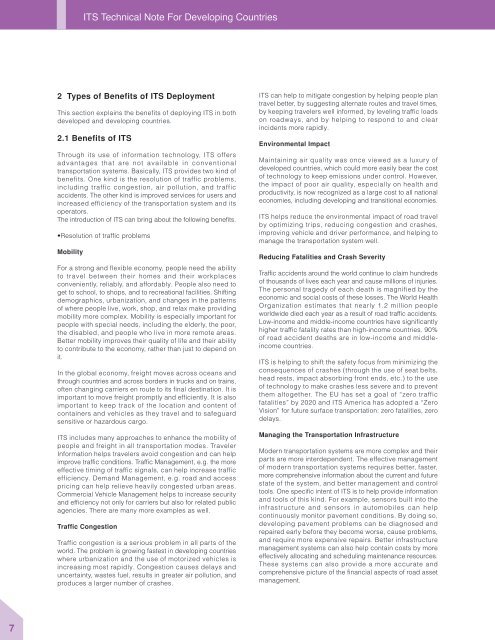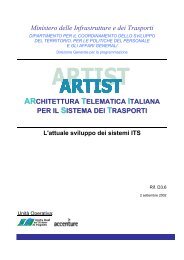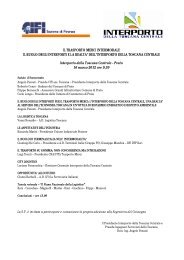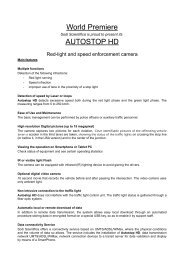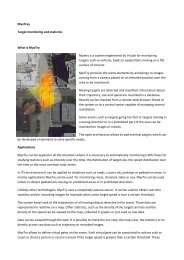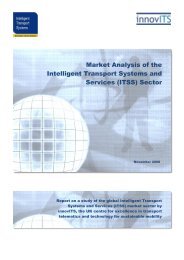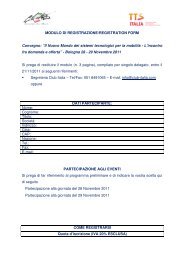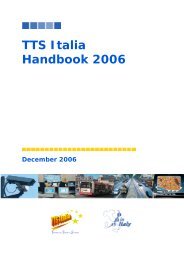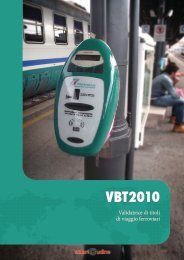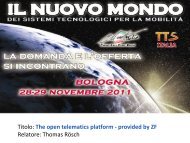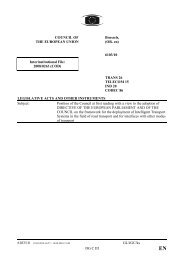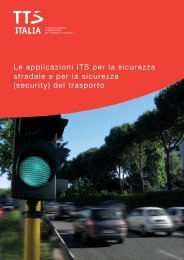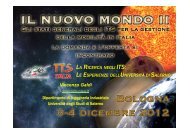ITS for Developing Countries ITS for Developing Countries - TTS Italia
ITS for Developing Countries ITS for Developing Countries - TTS Italia
ITS for Developing Countries ITS for Developing Countries - TTS Italia
You also want an ePaper? Increase the reach of your titles
YUMPU automatically turns print PDFs into web optimized ePapers that Google loves.
<strong>ITS</strong> Technical Note For <strong>Developing</strong> <strong>Countries</strong><br />
2 Types of Benefits of <strong>ITS</strong> Deployment<br />
This section explains the benefits of deploying <strong>ITS</strong> in both<br />
developed and developing countries.<br />
2.1 Benefits of <strong>ITS</strong><br />
Through its use of in<strong>for</strong>mation technology, <strong>ITS</strong> offers<br />
advantages that are not available in conventional<br />
transportation systems. Basically, <strong>ITS</strong> provides two kind of<br />
benefits. One kind is the resolution of traffic problems,<br />
including traffic congestion, air pollution, and traffic<br />
accidents. The other kind is improved services <strong>for</strong> users and<br />
increased efficiency of the transportation system and its<br />
operators.<br />
The introduction of <strong>ITS</strong> can bring about the following benefits.<br />
•Resolution of traffic problems<br />
Mobility<br />
For a strong and flexible economy, people need the ability<br />
to travel between their homes and their workplaces<br />
conveniently, reliably, and af<strong>for</strong>dably. People also need to<br />
get to school, to shops, and to recreational facilities. Shifting<br />
demographics, urbanization, and changes in the patterns<br />
of where people live, work, shop, and relax make providing<br />
mobility more complex. Mobility is especially important <strong>for</strong><br />
people with special needs, including the elderly, the poor,<br />
the disabled, and people who live in more remote areas.<br />
Better mobility improves their quality of life and their ability<br />
to contribute to the economy, rather than just to depend on<br />
it.<br />
In the global economy, freight moves across oceans and<br />
through countries and across borders in trucks and on trains,<br />
often changing carriers en route to its final destination. It is<br />
important to move freight promptly and efficiently. It is also<br />
important to keep track of the location and content of<br />
containers and vehicles as they travel and to safeguard<br />
sensitive or hazardous cargo.<br />
<strong>ITS</strong> includes many approaches to enhance the mobility of<br />
people and freight in all transportation modes. Traveler<br />
In<strong>for</strong>mation helps travelers avoid congestion and can help<br />
improve traffic conditions. Traffic Management, e.g. the more<br />
effective timing of traffic signals, can help increase traffic<br />
efficiency. Demand Management, e.g. road and access<br />
pricing can help relieve heavily congested urban areas.<br />
Commercial Vehicle Management helps to increase security<br />
and efficiency not only <strong>for</strong> carriers but also <strong>for</strong> related public<br />
agencies. There are many more examples as well.<br />
Traffic Congestion<br />
Traffic congestion is a serious problem in all parts of the<br />
world. The problem is growing fastest in developing countries<br />
where urbanization and the use of motorized vehicles is<br />
increasing most rapidly. Congestion causes delays and<br />
uncertainty, wastes fuel, results in greater air pollution, and<br />
produces a larger number of crashes.<br />
<strong>ITS</strong> can help to mitigate congestion by helping people plan<br />
travel better, by suggesting alternate routes and travel times,<br />
by keeping travelers well in<strong>for</strong>med, by leveling traffic loads<br />
on roadways, and by helping to respond to and clear<br />
incidents more rapidly.<br />
Environmental Impact<br />
Maintaining air quality was once viewed as a luxury of<br />
developed countries, which could more easily bear the cost<br />
of technology to keep emissions under control. However,<br />
the impact of poor air quality, especially on health and<br />
productivity, is now recognized as a large cost to all national<br />
economies, including developing and transitional economies.<br />
<strong>ITS</strong> helps reduce the environmental impact of road travel<br />
by optimizing trips, reducing congestion and crashes,<br />
improving vehicle and driver per<strong>for</strong>mance, and helping to<br />
manage the transportation system well.<br />
Reducing Fatalities and Crash Severity<br />
Traffic accidents around the world continue to claim hundreds<br />
of thousands of lives each year and cause millions of injuries.<br />
The personal tragedy of each death is magnified by the<br />
economic and social costs of these losses. The World Health<br />
Organization estimates that nearly 1.2 million people<br />
worldwide died each year as a result of road traffic accidents.<br />
Low-income and middle-income countries have significantly<br />
higher traffic fatality rates than high-income countries. 90%<br />
of road accident deaths are in low-income and middleincome<br />
countries.<br />
<strong>ITS</strong> is helping to shift the safety focus from minimizing the<br />
consequences of crashes (through the use of seat belts,<br />
head rests, impact absorbing front ends, etc.) to the use<br />
of technology to make crashes less severe and to prevent<br />
them altogether. The EU has set a goal of “zero traffic<br />
fatalities” by 2020 and <strong>ITS</strong> America has adopted a “Zero<br />
Vision” <strong>for</strong> future surface transportation: zero fatalities, zero<br />
delays.<br />
Managing the Transportation Infrastructure<br />
Modern transportation systems are more complex and their<br />
parts are more interdependent. The effective management<br />
of modern transportation systems requires better, faster,<br />
more comprehensive in<strong>for</strong>mation about the current and future<br />
state of the system, and better management and control<br />
tools. One specific intent of <strong>ITS</strong> is to help provide in<strong>for</strong>mation<br />
and tools of this kind. For example, sensors built into the<br />
infrastructure and sensors in automobiles can help<br />
continuously monitor pavement conditions. By doing so,<br />
developing pavement problems can be diagnosed and<br />
repaired early be<strong>for</strong>e they become worse, cause problems,<br />
and require more expensive repairs. Better infrastructure<br />
management systems can also help contain costs by more<br />
effectively allocating and scheduling maintenance resources.<br />
These systems can also provide a more accurate and<br />
comprehensive picture of the financial aspects of road asset<br />
management.<br />
7


